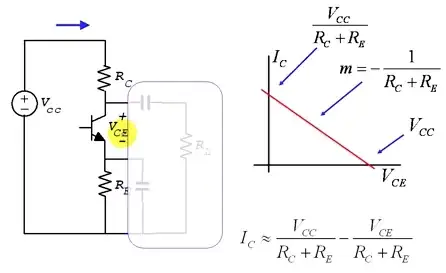(This is a rather longish answer to dig a little deeper into the connection between the AC load line and the maximum collector current and collector-emitter voltage).
What exactly is an AC Load line?
In words, and for this circuit, it is the plot of the collector current versus the collector-emitter voltage with the emitter bypass and collector coupling capacitors replaced with batteries with each battery voltage equal to the respective quiescent capacitor voltage.

simulate this circuit – Schematic created using CircuitLab
We'll get to why later. First, let's verify that this will give the AC load line.
When the collector current is zero, the collector voltage is, by voltage division
$$V_{C,max} = (V_{CC} - V_{CQ})\frac{R_L}{R_C + R_L} + V_{CQ} = I_{CQ}R_C||R_L + V_{CQ}$$
Thus,
$$V_{CE,max} = V_{C,max} - V_{EQ} = I_{CQ}R_C||R_L + V_{CEQ}$$
Assuming, for simplicity, that the saturation voltage is zero, \$V_{CE,sat} = 0V\$, the maximum collector current is
$$I_{C,max} = \frac{V_{CC} - V_{EQ}}{R_C} + \frac{V_{CQ} - V_{EQ}}{R_L} = I_{CQ} + \frac{V_{CEQ}}{R_C||R_L}$$
So, we have two located two points on the graph of \$i_C\$ versus \$v_{CE}\$
$$i_C = 0, v_{CE} = I_{CQ}R_C||R_L + V_{CEQ}$$
$$i_C = I_{CQ} + \frac{V_{CEQ}}{R_C||R_L}, v_{CE} = 0$$
The equation for the line through these two points is a load line and given by
$$i_C = I_{CQ} + \frac{V_{CEQ}}{R_C||R_L} - \frac{v_{CE}}{R_C||R_L}$$
Now, this load line has two notable characteristics:
(1) for \$v_{CE} = V_{CEQ}\$, the collector current is \$i_C = I_{CQ}\$ so this load line is through the quiescent point.
(2) the change in collector-emitter voltage is \$\Delta v_{CE} = -\Delta i_C R_C||R_L\$
But this is just the AC load line!
Returning to the question of why replace the capacitors with batteries. Recall that, for AC analysis, the bypass and coupling capacitors are considered AC short circuits, i.e., the AC voltages across the capacitors are zero.
Thus, from a total (DC + AC) voltage perspective, the total voltages across the capacitors are constants and equal to their quiescent voltages.
In other words, if we assume the capacitors are AC short circuits for signal analysis, we can replace the capacitors with constant voltage sources, i.e., batteries for this DC + AC analysis.


